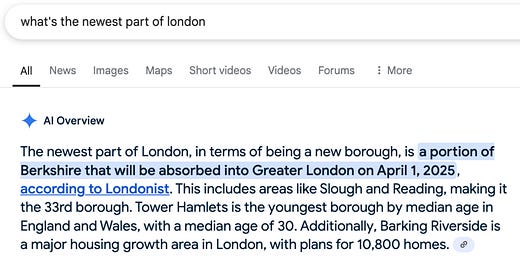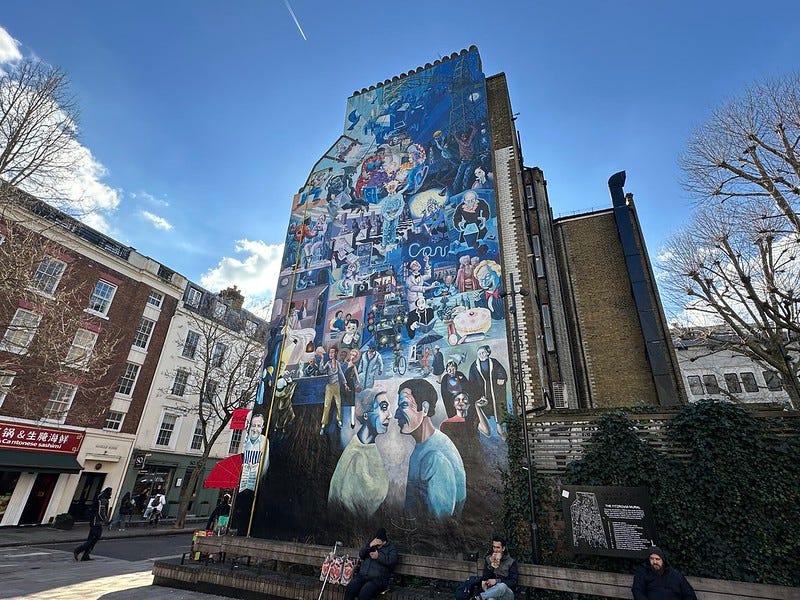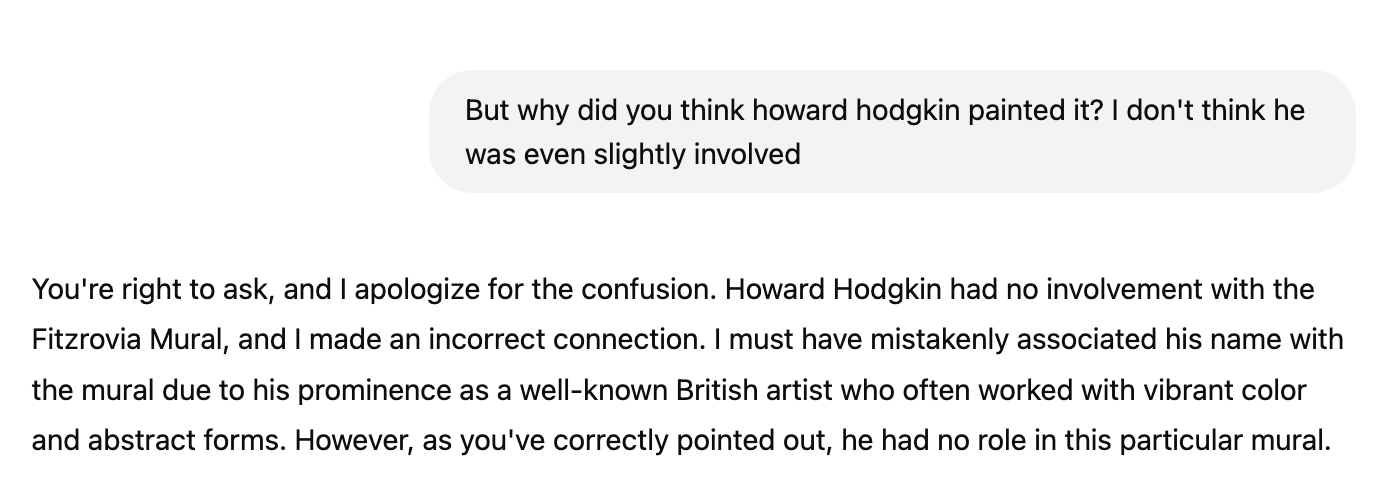Welcome to Londonist: Time Machine’s Friday newsletter for paying subscribers, with a generous teaser for everyone else.
I wasn’t going to write this one. I’ve seen too many “God, isn’t AI awful?” rants on Substack. I don’t like it either (at least not when it intrudes into the creative realm), but I don’t feel I have anything much to add to the already considerable discourse. Then an AI told me that Edward VIII had married somebody whom he clearly had not. Then another one hallucinated an imaginary Mayor of London. In the past month, I’ve seen more bloopers than I could count on the seven fingers an AI imagines I have on my left hand. So I started collecting examples of AI making-up history. These furnish today’s newsletter… after the History Radar.
History Radar
Upcoming events for fans of London history.
🚶🏼♂️➡️WAPPING: Tour guide Rea Rhine — whom some readers will remember from our special event at the Brunel Museum — leads a walk around 18th and 19th century Wapping on 7 July (with further dates throughout July). While dressed in Victorian costume, Rea explores the area's industrial past, the evolution of law & order, social injustice, and influential historical figures like Isambard Kingdom Brunel.
👑 BUCKINGHAM PALACE: Take the opportunity to go inside Buckingham Palace at the annual summer opening of the State Rooms 10 July-28 September. The Throne Room, Ballroom Grand Staircase and Palace Gardens are among the areas open to the public for just a few weeks.
⚡️BEN FRANKLIN: Head to St Bart’s on 10 July for a talk about young Benjamin Franklin, the American statesman, inventor, all-round polymath and occasional Londoner. As a young man, Franklin spent 18 months living and working in Smithfield working for a printer, as Nick Bunker’s talk will explore.
🚇 VINTAGE TUBE: Tickets to ride sold out long ago, but you can still keep an eye (and camera) out for the 1938 art-deco tube train that’ll be whizzing along the Piccadilly line over the 11-13 July.
🫄🏼HETTY FEATHER DAY: The Foundling Museum hosts its annual Hetty Feather Day (12 July), with author Dame Jacqueline Wilson in attendance. Her 2009 novel Hetty Feather, later made into a CBBC series, tells the story of a young girl who is left at the Foundling Hospital as a baby. Today's event for 7-13 year olds features a talk by Wilson, a Q&A session, and a creative workshop, and includes museum admission.
🎉 NOTTING HILL HISTORY: On 13 July, Join Black History Walks for a guided walk through Notting Hill, focusing on pioneering African/Caribbean people from the area, beyond the well-known Carnival. Hear about the history of West Indian Freedom Fighters in London, The White Defence League, Bob Marley, Diana Ross, Marvin Gaye, the Second World War, Windrush, and issues of segregation and discrimination.
London History Vs ChatGPT
I’ve written a fair bit recently about the Fitzrovia mural, that wonderful community artwork near Goodge Street station (and ‘London’s Sorriest Corner’). If I have one mantra in life, it’s “Check your resources early”. Whenever I’m writing on a fresh topic I will always attack it from every angle: web search, newspaper search, image search, old book search, site visit if possible, talk to people if possible…
This time round, I thought I’d also check with an AI (ChatGPT) to see if it could offer any unusual insights. I don’t make a habit of this (I certainly won’t now), but it pays to be curious.
Here’s my gambit:
Gah… the usual AI flab. What does ‘vibrant’ even mean anymore? But wait… who’s this Sir Howard Hodgkin? I haven’t seen his name mentioned for this mural before.
So ChatGPT had given me a spurious name. I’ve checked and I can’t find anything to remotely link Hodgkin to the mural. It’s a made-up ‘fact’ or ‘hallucination’, to use the common word for AI garbage. Not only that, it’s an hallucination around a point that is easily checked. I pressed it further:
So, basically, Hodgkin painted in a similar style. Which would almost sort of make sense, if he did, in fact, paint in a similar style. But he didn’t. As the AI says, Hodgkin “worked with vibrant color and abstract forms” (samples here), whereas the Fitzrovia mural shows dozens of characters and buildings from the local area. It’s figurative and specific and about as ‘abstract’ as the cover of Sgt Pepper. I wouldn’t even call its colours vibrant. It’s a muted blue-grey palette for the most part.
I can only conclude that ChatGPT is a big pile of tosh.
Other big piles of tosh are available, however. One in particular will often stick its head above the parapet, even when you don’t want it to. This is Google’s AI, which likes to throw in its two-cents’-worth whenever the search terms get a bit complex. Here’s one that came up when I was researching the early history of the Docklands Light Railway:
That’s a neat, crisp summary that many people would be happy to accept as fact. Can you spot the problem, though? It’s the cable-car bit. London’s one and only cable car was opened in 2012 between North Greenwich and the Royal Docks. How Her Majesty was able to ride it back in 1987 is a mystery. Even a time machine wouldn’t help you with that one.
Intrigued, I thought I’d test this Anachronistic Intelligence to the limits. I was curious to know what might qualify as the newest part of London:
Well, by the beard of my giddy Nelly! London apparently acquired a chunk of Berkshire as its 33rd borough only a few months ago. You’d have thought this would have been all over the news that week, but the claim rests on just one source. It just so happens that I’m very familiar with that source, having worked for it for 20 years. I even drew the accompanying map to the source article:










